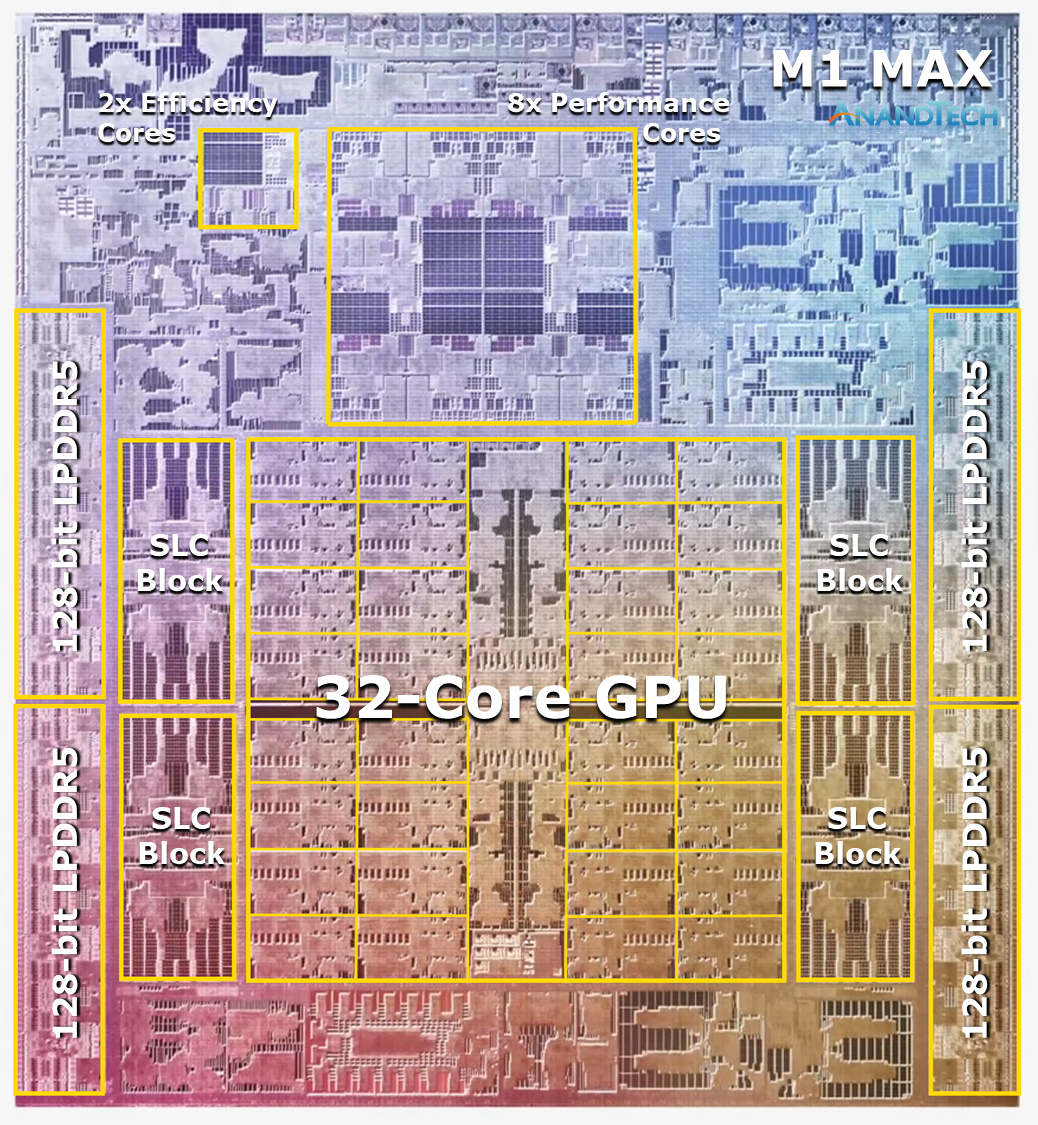D
Deleted member 11852
Guest
There is also a middle-ground M1MAX 24 GPU core option that I didn't note during the keynote, or maybe my brain had just frozen at that point.GPU cores: 32 versus 16
There is also a middle-ground M1MAX 24 GPU core option that I didn't note during the keynote, or maybe my brain had just frozen at that point.GPU cores: 32 versus 16
Sorry, meant 2023. A little over a year.Rembrandt is N6 in 2022, so I don't think it'll take another 2 years for the APUs to reach N5.
I'm not sure what you are trying to argue. These notebooks are specifically for content creators and no other solution support hardware encode and decode of ProRes. It's faster than the 28-core Mac Pro with the $2,000 AfterBurner card.
The graphic card alone uses much more power than the entire M1 Max and would probably not be competitive on battery power anyway. No other mobile solution offers that much frame buffer (up to 64GB) or 400GB/s bandwidth.
It isn't just the node advantage but Apple have been making low power devices for a decade now and are able to leverage that know-how. Arm is just more power efficient than x86.
The price is absolutely warranted but I get your point, you don't need it and can already find alternatives that better suit you needs, great.
Geekbench 5 for M1 Max is out: https://browser.geekbench.com/v5/compute/3551790
That is on par with the RTX 3050 TI mobile: https://browser.geekbench.com/v5/compute/3552028
RTX 3080 mobile in the Razerblade 14" is ~2x faster in Geekbench 5.
I thought openCL wasnt used anymore in Mac'sGeekbench 5 for M1 Max is out: https://browser.geekbench.com/v5/compute/3551790
That is on par with the RTX 3050 TI mobile: https://browser.geekbench.com/v5/compute/3552028
RTX 3080 mobile in the Razerblade 14" is ~2x faster in Geekbench 5.
Actually if it is, it would be useful to see what kind of device capabilities the hardware reports, e.g. hardware thread size, shared memory etc.I thought openCL wasnt used anymore in Mac's
1.2 impl is built on top of Metal iirc.I thought openCL wasnt used anymore in Mac's
OpenCL was deprecated back in 2018 in favour of Metal. Like OpenGL, then framework is still there but it has not had any enhancements to support modern hardware or other APIs that would otherwise accelerate its performance. Ergo, it probably not a relevant reference point to platforms where OpenCL is actively being developed.I thought openCL wasnt used anymore in Mac's
Apple will likely have an understanding with TSMC to outbid for any 3nm capacity coming online for consumer PC products for at least 2 years (Qualcomm&co and Intel server products can get some space to make the monopoly dealings a little less obvious, they don't need the node advantage to push iphones).
AMD hopefully getting 5nm in 2024 and reducing the node disadvantage to a single node will be an improvement on the current situation, but the market is busted.
I thought Zen 4 was going to be on 5nm for 2022?
It is 5nm and 2022. Ridiculous to even think AMD would "hopefully" get 5nm by 2024 or that Apple would have exclusive or near exclusive rights to process for 2 years
It is 5nm and 2022. Ridiculous to even think AMD would "hopefully" get 5nm by 2024 or that Apple would have exclusive or near exclusive rights to process for 2 years
Do you have a link for the best, most-detailed, description of these new chips?
There's about 23B transistors extra in M1 Max (57B) versus M1 Pro (33.7B) and it seems there are two key differences:
So how does Apple spend so many transistors? 23B transistors is equivalent to pretty much all the transistors in Navi 21 (26.8B). All of 6700XT is only 17.2B transistors.
- GPU cores: 32 versus 16
- Off-die memory system: 400GB/s versus 200GB/s

Good stuff.Looking at the die shot it appears that the NPU is doubled as well on the M1 Max.
So we have the GPU, display engine, media engine, neural engine, the extra 256-bit memory interface as well as the system level cache.
Monitor support is vastly extended. (Apple demonstrated Laptop screen (7MP) + 3x6k monitors + 4k television)Good stuff.
Why would the display engine change (or why would there be more of it)? Similar question for media engine?
Monitor support is vastly extended. (Apple demonstrated Laptop screen (7MP) + 3x6k monitors + 4k television)
The media engine has hardware support for ProRes video - presenter lady said 30 simultaneous 4k streams or 7 simultaneous 8k streams, outperforming a top end (28-core Xeon) Mac Pro with Apples own $2000 Afterburner card.
I notice not many games from 2019 onwards on this list
https://en.wikipedia.org/wiki/Metal_(API)
why is this? Sure gaming is very small on Mac, but is this the only reason?
Hmmm I couldnt find any benchmarks with metal in actual games, I could only find rosetta
Actually you can’t boot into Windows anymore, Windows on ARM doesn’t support Mac hardware.Yes you can boot into windows, but on the new M1 processors surely this is running through an emulator thus slowing everything down with that extra layer, Thus it won't give you the best gaming experience. Or am I wrong?
Actually you can’t boot into Windows anymore, Windows on ARM doesn’t support Mac hardware.
While you can convince the Apple Silicon macs to run Windows, (tenacious software guys can perform miracles) it’s not a very meaningful way to access the Windows game library IMHO. Buying a Windows box makes a ton more sense, if that is what you want. Boot Camp is dead.
Speaking as a geek - the M1 Pro Max is BY FAR the most powerful TBDR GPU ever produced. I would love to see graphics coded to take advantage of it!
